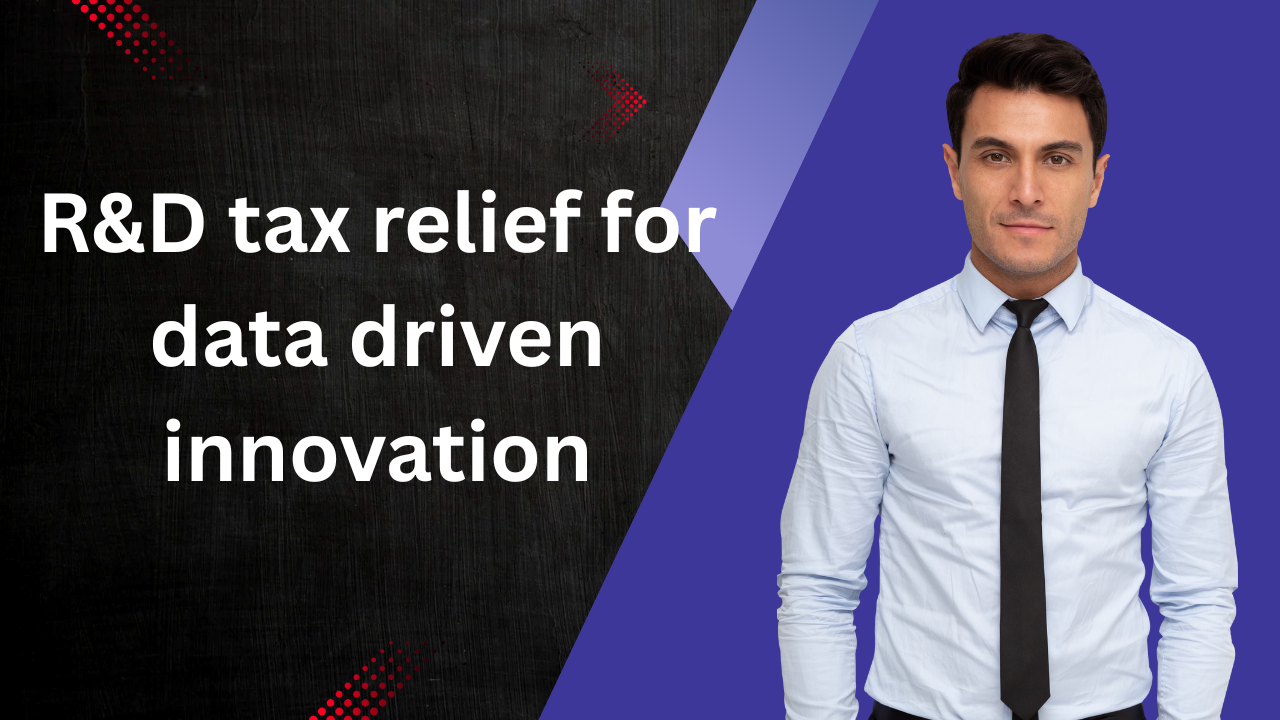R&D Tax Relief for Data Driven Innovation: A Complete Guide
In today’s fast-changing business world, data has become one of the most valuable assets. Companies that use data well are able to make better decisions, develop smarter products, and gain an edge over competitors. This process is known as data driven innovation.
But innovation comes at a cost. Many businesses find that while they want to invest in advanced systems such as AI, machine learning, or predictive analytics, the financial pressure is heavy. This is where R&D tax relief can make a real difference.
This guide explains how R&D tax credits can support data driven innovation, what projects qualify, and how UK companies can claim relief to ease financial burdens and accelerate growth.
What Is Data Driven Innovation?
Data driven innovation means using data to guide decisions, create new products, and improve services. Instead of relying on guesswork, businesses turn raw data into actionable insights that help shape strategy.
The main tools used in data driven innovation include:
- Data analytics – studying datasets to identify patterns, trends, or gaps
- Artificial intelligence (AI) – systems that learn and adapt from data
- Machine learning (ML) – algorithms that improve as they process more information
Examples of Data Driven Strategies in Business
- Manufacturing – using data to optimise production lines and reduce waste
- Retail – analysing customer habits to create personalised product recommendations
- Healthcare – using data to predict patient needs and improve outcomes
- Finance – detecting fraud by analysing unusual activity patterns
Role of AI, Machine Learning, and Analytics
AI and ML play a crucial role in pushing data driven projects forward. They allow businesses to build smarter systems such as predictive analytics, automated decision-making, and intelligent software tools.
The result? More efficient operations, stronger customer experiences, and a better chance of staying ahead of competitors.
Why Data Driven Innovation Matters for Business Growth
Businesses that harness data have a clear advantage. Beyond the buzzwords, there are real benefits to adopting a data driven approach:
Competitive Advantage
Companies that innovate with data can identify opportunities faster than their competitors. They can spot market gaps and act before others do.
Customer Experience Improvements
By using data to understand customer behaviour, businesses can personalise products and services. This creates stronger relationships and brand loyalty.
Cutting Operational Costs
Data driven systems often highlight inefficiencies. Fixing them can save money on processes, staffing, and materials.
When combined, these benefits fuel long-term growth and create a solid foundation for scaling a business.
How R&D Tax Relief Supports Data Driven Projects
Innovation is rewarding, but it is rarely cheap. UK businesses that invest in research and development can claim R&D tax relief to recover a portion of their costs.
HMRC’s Definition of Qualifying R&D
According to HMRC, a project qualifies if it seeks to:
“Achieve an advance in science or technology by overcoming a level of uncertainty that professionals in the field cannot easily solve.”
This means you do not need to be working in a laboratory or inventing something completely new. If you are trying to improve systems, processes, or software in a way that pushes technology forward, your project may qualify.
Eligible Costs for Data Driven Innovation
Some of the most common costs that can be included in a claim are:
- Software costs – for programs directly used in R&D work
- Direct staff costs – salaries, pensions, NIC, and time spent on projects
- Consumables – data storage, utilities, and materials used in development
- Collaborative work – costs of partnering with other companies or institutions
Keeping clear records of these expenses is essential, as HMRC requires evidence for claims.
Software, Staff, and Collaborative Projects
Many data driven projects rely on expensive software licences, specialist staff, or external collaboration. R&D tax relief helps offset these costs so that innovation can continue without draining resources.
Real-Life Example of Data Driven R&D Success
To see the impact of R&D tax credits, let’s look at a real case study.
A UK e-commerce business wanted to rethink how product recommendations were delivered to customers. They invested in AI and psychology research to build a recommendation-as-a-service (RaaS) system.
The project required:
- Advanced AI development
- Data analysis infrastructure
- Ongoing testing and refinement
The business invested a large sum of money and resources. By applying for R&D tax relief, they were able to secure over £166,000 in relief, which reduced financial strain and allowed the system to launch successfully.
The result? Better customer experiences, higher sales, and a long-term competitive edge.
FAQs About Data Driven Innovation and R&D Tax Credits
What types of data driven projects qualify for R&D relief? Any project that uses data to achieve a scientific or technological advance can qualify. This includes AI systems, predictive analytics, or process automation.
Can AI and machine learning projects claim tax credits? Yes. Projects that use AI or ML to solve technical challenges and create new systems are often eligible.
How much can UK businesses claim? Businesses can claim up to 33% of eligible costs, depending on whether they qualify under the SME scheme or the RDEC scheme for larger companies.
Do SMEs and large businesses qualify differently? Yes. SMEs can claim a higher percentage of relief, while larger businesses usually fall under the RDEC scheme.
What documentation is required for a claim? You should keep records of project aims, technical challenges, staff time, costs, and outcomes. The clearer the evidence, the stronger your claim will be.
Getting Started With Your R&D Tax Credit Claim
Applying for R&D tax credits can be straightforward with the right guidance. Here are some steps to follow:
- Identify qualifying projects – check if your data driven work meets HMRC’s criteria.
- Gather cost records – keep track of staff, software, and consumables.
- Write a technical report – explain how your project advanced science or technology.
- Submit your claim – usually as part of your company’s Corporation Tax return.
Why Professional Guidance Helps
Many businesses miss out on relief because they don’t realise their projects qualify, or they underclaim by leaving out eligible costs. Working with a specialist ensures that your claim is accurate and maximised.
Common Mistakes to Avoid
- Assuming only laboratory work qualifies
- Forgetting to document staff time
- Excluding software costs
- Overlooking collaborative projects
Next Steps: Secure Funding for Your Data Driven InnovationData driven innovation is shaping the future of business. With the right funding support, your company can take bold steps without being held back by financial constraints.
Ready to see how much you could claim? Book your free consultation today:







